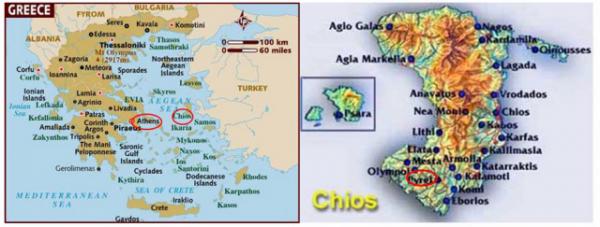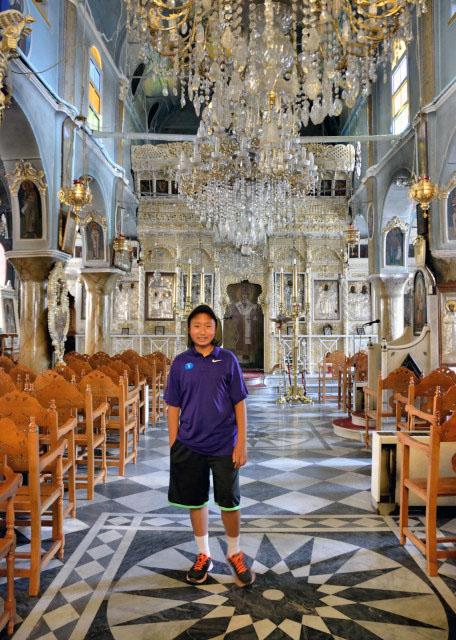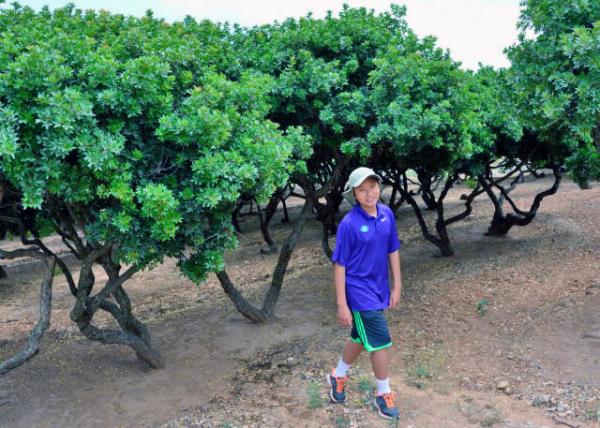2015-06-22

【Aiden in English】
When something becomes old, it is often viewed as a negative sign. But sometimes, being old and crippled can mean a resurrection, a boast of good revival. The medieval village of Pyrgi was set up as the best example. It was built in its present form, featuring heavy gates and narrow but winding streets, in the 13th century. As the oldest village in Khios, the aromatic lentisk trees flourish on Khios and produce the "tears of Khios." The local people have controlled the trade in mastic gum since Roman times. Mastic gum is the best in the world. Nowadays, Pyrgi still bears its history on its walls; for example, houses covered with sgraffito or xysta feature geometric designs in black and white plaster. The techniques apply to an unfired ceramic body with two successive layers of contrasting slip, followed by scratches to create an outline drawing. Look up and see ceramic buildings with wall décorthat reflect centuries-old traditions. Look up even higher, and you'll see a mosque showing the taint of Christianity in this place. The surrounding walls looked stout and were constructed to protect the mastic inventory and the wealth it produced from pirates. It is essential that the village of Pyrgi was exempted from the frightful 1822 massacres. The ceramics on the road were made in local kilns. One thing I learned about on this trip is that beautiful ceramics, tempting olives, and stupid politicians are three subjects that Greece has too much of. The tiles on the buildings were made centuries ago, and the locals used to carve on black sandstone. This was all built off even older structures. What I find remarkable about this village is how it can maintain a state where modern and medieval cultures coexist peacefully, without one side overpowering the other. History can be seen in the town of Pyrgi, while the contemporary takes center stage in its own right. I love that the new lives in the old, saving money and space. It's like recycling. The old village is falling out of use. Add some things and fix them by reusing outdated stuff, an alternate type of recycling. If the human race worked like that every day, maybe we wouldn't be facing the problem of landfills. I'm going to use a phrase said in the movie "Kingsman: The Secret Service." Something goes like this. "If the world were a person and humanity were a virus, there would only be two results. But ultimately, it will be the end of both. The host kills the virus, or the virus kills the host". If we recycle more and do not kill so many trees, we will probably be able to solve many problems. Our ancestors of us may seem clueless about the capacity of our brains. However, they could have some more sense than us, recycling a village like Pyrgi. I hope this “sense” can be passed on in genes. Or else, well, the earth would be sucked dry on resources, and THE END! 【红霞译】
一般来说,东西变旧不是什么好兆头,但老的不去新的不来,有时新陈代谢并非坏事。中世纪古镇画村皮尔吉“塔”堪称典范,其现存又大又重的城门建于13世纪,狭窄蜿蜒的街区也是七百年前遗留的产物,这个所谓希俄斯岛历史最悠久的古镇黄连木芬芳遍野,盛产“希俄斯岛之泪”──乳香树脂,早在罗马时代,希俄斯岛人就已开始掌控乳香贸易,其质量被视为世界第一。
皮尔吉历史源渊流长,文物古迹屡见不鲜,建筑彩绘即为最佳佐证,其绘制方式是,先在未经烧陶的瓷具上绘制出两个不同层次的几何图案,然后通过打磨来突出线条轮廓。你若抬头看去,不难发现房舍墙壁上贴满具有几百年传统特色的装饰性瓷砖;再往高处远望,一座清真寺不太谐调地从基督教区突兀而起。皮尔吉的城墙嵩厚敦实,当年被用来保护村镇乳香产业抵御海盗侵袭,正因为乳香影响深远,皮尔吉才免遭1822年灭顶之灾。
皮尔吉陶瓷烧烤全部沿袭当地传统工艺,此行出游让我印象最深的离不开三个方面:漂亮的彩绘、馋人的橄榄和可笑的政客,希腊狂揽一切。这里瓷砖生产史可以追溯回数百年前,当地人擅长黑砂岩雕刻艺术,并广泛用于房舍装饰。亲眼目睹画村建筑彩绘之后,我深切感叹古今文化浑然一体,两者相得益彰,从而共同提升了时代魅力;现代的东西如果凌驾于历史底蕴之上,即使再时髦也显得非常单调。就节省财富和保护环境而言,我赞成古为今用,正如回收一样,既然老城破烂不堪,倒不如巧用新东西去改良旧事物,让旧貌换新颜。倘若人类终日坚持回收理念,也许能够避免陷入垃圾成灾的困境。这里借用好莱坞电影《王牌特工:特工学院》里一段对话,“假设世界由人类主导而人类又是病毒的话,眼前将出现两种结果,要么宿主干掉病毒,要么病毒吞噬宿主,但弄不好会两败俱伤”。我们只有废物利用,不再滥伐森林,才有可能解决其它更多问题。 我们的祖先或许无法预估时代变革,然而从皮尔吉这样珍惜现有财富这方面来看,古人做事确实比后代明智。我希望大家能够发扬先辈的光荣传统,否则地球资源迟早要被消耗殆尽。
Today in History(历史上的今天):
2015: New Monastery of Khios, Greece(希腊希俄斯岛·新修道院) 2015: Homer's Stone on Khios, Greece(希腊希俄斯岛·荷马岩) 2015: Medieval Fortified Village, Khios(希腊希俄斯岛·中世纪土围子) 2014: California Pizza Kitchen(火炉皮萨饼屋)
2011: 二年级夏令营(2nd Grade Summer Camp)  Façade of Theotokos Church @ Pyrgi Façade of Theotokos Church @ Pyrgi
(皮尔吉村·圣像教堂正面观) 
Clock Tower of Theotokos Church @ Pyrgi (皮尔吉村·圣像教堂钟楼) 
The Nave of Theotokos Church @ Pyrgi (皮尔吉村·圣像教堂中殿 06-22-2015) 
Carving @ Pyrgi (皮尔吉村·石刻)  15th-Century Church of the Holy Apostles @ Pyrgi 15th-Century Church of the Holy Apostles @ Pyrgi
(皮尔吉村·十六世纪圣使徒教堂) 
Pyrgi Tradition (皮尔吉村传统)  Village Central @ Pyrgi (皮尔吉村·村中心) Village Central @ Pyrgi (皮尔吉村·村中心)

Arches or Vaults-Covered Medieval Narrow Alley @ Pyrgi (皮尔吉村·拱门或拱顶覆盖的中世纪狭窄胡同)

Painted Village @ Pyrgi (皮尔吉·彩绘村庄 06-22-2015)  House Covered w/ Sgraffito or Xysta @ Pyrgi House Covered w/ Sgraffito or Xysta @ Pyrgi
(皮尔吉村·五彩拉毛粉饰建筑) 
Gift Shop @ Pyrgi (皮尔吉村·礼品店)  Demo of Sgraffito @ Pyrgi Demo of Sgraffito @ Pyrgi
(皮尔吉村·讲解五彩拉毛粉饰 06-22-2015) 
Mastic Gum Trees (乳香树 06-22-2015)  Mastic Gum or God's Tears (乳香树脂·上帝的眼泪) Mastic Gum or God's Tears (乳香树脂·上帝的眼泪)
Crosslinks(相关博文): Greece(出游希腊)
Europe(欧洲掠影) 6th Grade(初中一年级)
|
